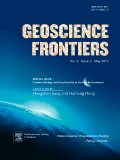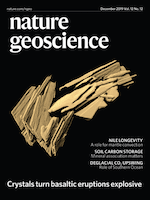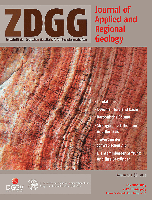
Geoscience Frontiers
Scope & Guideline
Exploring Frontiers in Earth and Planetary Sciences
Introduction
Aims and Scopes
- Environmental Geochemistry:
Research focusing on the chemical processes and interactions within geological systems, particularly how they affect environmental quality and sustainability. - Geological Modeling and Simulation:
Studies that employ advanced modeling techniques, including machine learning and artificial intelligence, to simulate geological processes and predict outcomes in areas such as landslide susceptibility and groundwater dynamics. - Tectonics and Geodynamics:
Investigations into the processes that shape the Earth's crust, including plate tectonics, mountain formation, and the evolution of continental and oceanic structures. - Natural Resource Management:
Research on the sustainable extraction and utilization of natural resources, including minerals, water, and energy, often integrating economic and ecological perspectives. - Climate Change Impact Studies:
Examinations of how geological and environmental factors contribute to climate change, as well as the effects of climate change on geological processes and natural resources. - Remote Sensing and Geospatial Analysis:
Utilization of remote sensing technologies and geospatial data analysis to study geological phenomena, assess environmental changes, and support resource management. - Innovative Geoscience Technologies:
Exploration of new technologies and methodologies in geoscience research, including the application of data science and computational techniques to enhance understanding of geological systems.
Trending and Emerging
- Climate Change Mitigation Strategies:
Research focusing on the role of geosciences in addressing climate change, including carbon capture, sustainable resource management, and environmental restoration, is gaining increasing attention. - Machine Learning and AI Applications:
The use of machine learning and artificial intelligence in geological research has surged, with applications in predictive modeling, data analysis, and enhancing the accuracy of geoscientific investigations. - Sustainable Energy Solutions:
Studies on renewable energy sources, energy efficiency, and the environmental impacts of energy production are trending, reflecting a global shift towards sustainable development. - Water Resource Management and Quality Assessment:
There is a growing focus on the assessment and management of water resources, particularly in relation to contamination, sustainability, and climate variability. - Geochemistry of Natural Hazards:
Research investigating the geochemical processes associated with natural hazards, such as landslides and earthquakes, is increasingly relevant in the context of risk assessment and mitigation. - Integrative Approaches to Geosciences:
Interdisciplinary research that combines geological, environmental, and technological perspectives is trending, fostering holistic understandings of complex geoscientific issues.
Declining or Waning
- Traditional Mineral Exploration Techniques:
Research focusing on conventional methods for mineral exploration has seen a decline, as newer technologies and interdisciplinary approaches become more prominent. - Geological Mapping without Technological Integration:
Papers that rely solely on traditional geological mapping techniques, without the incorporation of modern tools such as GIS or remote sensing, are becoming less common. - Paleontological Studies:
While still important, the frequency of studies specifically focused on paleontology and fossil records has decreased, possibly overshadowed by more pressing environmental and geochemical topics. - Single-Disciplinary Studies:
Research that does not integrate multiple disciplines or methodologies is becoming less prevalent, as the journal increasingly emphasizes interdisciplinary collaboration. - Basic Geochemical Analysis:
Basic studies on geochemical properties, without application to broader environmental or resource management issues, are receiving less attention compared to more applied research.
Similar Journals

Economic and Environmental Geology
Connecting Research and Practice in Economic and Environmental GeologyEconomic and Environmental Geology is a peer-reviewed journal published by the Korea Society for Economic & Environmental Geology, focusing on critical intersections within the fields of economic geology and environmental science. With an ISSN of 1225-7281 and an E-ISSN of 2288-7962, this journal serves as a vital platform for researchers, professionals, and students engaged in the comprehensive study of geological resources and their impacts on the environment. As of 2023, the journal is categorized in the Q4 quartile for both Economic Geology and Environmental Science, indicating its emergent impact in these domains. Despite being in the early stages of its convergence from 2017 to 2024, the journal holds importance for advancing knowledge and fostering discussions about sustainable geological practices in South Korea and beyond. The journal does not currently offer open-access options, but it continues to provide essential insights into the challenges and innovations within economic and environmental geology.

INTERNATIONAL JOURNAL OF EARTH SCIENCES
Championing Open Access for Groundbreaking DiscoveriesINTERNATIONAL JOURNAL OF EARTH SCIENCES, published by Springer, is a leading journal in the field of Earth and Planetary Sciences, distinguished by its Q1 quartile ranking in the 2023 category of Earth and Planetary Sciences (miscellaneous). With an ISSN of 1437-3254 and an E-ISSN of 1437-3262, this journal has been a pivotal platform for researchers, academics, and practitioners since its inception in 1996. The journal's focus encompasses a broad range of topics within Earth sciences, making it a vital resource for contributions that enhance our understanding of geological processes, climate change, and planetary dynamics. The impact factor reflects its high standards and the significance of the research it publishes, ranking it in the 74th percentile among its peers as per Scopus. Furthermore, the journal offers Open Access options, facilitating the global dissemination of groundbreaking research. The editorial team is committed to advancing knowledge in Earth sciences, serving as an essential reference for students and professionals looking to engage deeply with this dynamic field.

Earth Science Informatics
Pioneering Interdisciplinary Collaboration in Earth Science.Earth Science Informatics, published by SPRINGER HEIDELBERG, serves as a premier platform for disseminating innovative research in the realm of Earth and Planetary Sciences. With an ISSN of 1865-0473 and an E-ISSN of 1865-0481, this journal offers insightful contributions that leverage informatics and data-driven approaches to address complex geoscientific challenges. As a testament to its impact in the field, it ranks in the Q2 quartile and holds an impressive 73rd percentile rank among 195 journals in the broader **Earth and Planetary Sciences** category, as per Scopus rankings. This journal invites researchers, professionals, and students to explore and contribute to the growing body of knowledge that bridges the gap between informatics and Earth science, fostering advancements in both theoretical frameworks and practical applications. Situated in Germany, at TIERGARTENSTRASSE 17, D-69121 HEIDELBERG, it aims to enhance interdisciplinary collaboration and propel scientific discovery from 2009 to 2024 and beyond, reinforcing its vital role in the academic community.

GEOSCIENCES JOURNAL
Charting New Territories in Earth and Environmental Science.Welcome to the GEOSCIENCES JOURNAL, a pivotal publication in the fields of Earth and Planetary Sciences and Environmental Science, proudly presented by the Geological Society of Korea. Established in 1997, this journal has become a prominent platform for researchers, professionals, and students, offering a rich collection of peer-reviewed articles that explore a diverse array of geoscientific topics. With an impressive Q2 ranking in both Earth and Planetary Sciences and Environmental Science categories for 2023, it stands as an essential resource in the academic community. Though it operates under a traditional subscription model, GEOSCIENCES JOURNAL remains dedicated to advancing knowledge through rigorous research. Addressed from its headquarters in Seoul, South Korea, the journal aims to foster a deeper understanding of geosciences, encouraging innovation and collaboration in tackling today’s environmental challenges.

DOKLADY EARTH SCIENCES
Bridging Gaps in Earth Science UnderstandingDOKLADY EARTH SCIENCES is a reputable journal published by MAIK NAUKA/INTERPERIODICA/SPRINGER, focusing on the dynamic field of Earth and Planetary Sciences. With an ISSN of 1028-334X and E-ISSN 1531-8354, this journal offers a platform for researchers to disseminate their findings and insights that contribute to our understanding of Earth systems over a continuous publishing span from 1998 to 2024. It currently holds a Q3 quartile ranking in the Earth and Planetary Sciences category, reflecting an emerging yet significant impact within its field, evidenced by its Scopus ranks where it stands at 123rd in general Earth sciences and 113th in miscellaneous Earth sciences. DOKLADY EARTH SCIENCES aims to bridge research gaps and foster collaboration among a diverse audience including researchers, professionals, and students committed to advancing knowledge in geoscience. The journal stands as a vital resource for those seeking to explore contemporary challenges and innovations within the realm of Earth sciences.

JOURNAL OF THE GEOLOGICAL SOCIETY OF INDIA
Illuminating the landscape of geological science since 1979.JOURNAL OF THE GEOLOGICAL SOCIETY OF INDIA, published by Springer India, serves as a pivotal platform for researchers and practitioners in the field of geology. Established in 1979, this journal has been instrumental in advancing geological research throughout India, showcasing both regional studies and cutting-edge global research. With its Category Quartile ranking of Q3 in the geology category for 2023, and a significant Scopus rank of 171 among 321 journals in Earth and Planetary Sciences, it remains a respected source of scholarly activity. The journal is dedicated to the dissemination of original research articles, reviews, and case studies that encapsulate the dynamic scope of geological science, thus contributing to the understanding of geological phenomena. Although currently not offering open access, the journal maintains a commitment to high-quality scholarship and aims to engage a diverse readership, enhancing the knowledge and practice of geology across various disciplines.

Nature Geoscience
Transforming Insights into Action for Our Planet.Nature Geoscience, a premier journal published by NATURE PORTFOLIO, provides a platform for the dissemination of high-quality research in Earth and Planetary Sciences. With an impressive impact factor reflecting its significance — ranking in the 99th percentile and positioned at #1 out of 195 in Scopus Ranks within its category, this journal is a leading authority in its field. Since its inception in 2008, it has fostered interdisciplinary collaboration, addressing critical challenges such as climate change, natural disasters, and resource management. Although it does not offer Open Access, the journal is accessible through various research libraries, ensuring that vital findings reach a broad audience. The journal's esteemed reputation in the Q1 quartile of Earth and Planetary Sciences makes it an essential resource for researchers, professionals, and students aiming to advance their understanding of geoscientific phenomena.

GEOLOGIA CROATICA
Driving Innovation in Geological UnderstandingGEOLOGIA CROATICA is a distinguished open-access journal published by the Croatian Geological Survey, dedicated to advancing the field of Earth and planetary sciences. Since its inception in 1992, this peer-reviewed journal has become an essential resource for researchers, professionals, and students interested in various aspects of geology. With its robust impact factor and a prestigious place in Scopus rankings, ranking 127th out of 321 in Geology and 77th out of 159 in miscellaneous Earth and Planetary Sciences as of 2023, GEOLOGIA CROATICA maintains a strong international presence. It provides a platform for the dissemination of critical research findings, promoting collaboration and knowledge sharing among the global scientific community. By focusing on high-quality manuscripts that cover geological processes, hazards, and resources, this journal is pivotal for anyone looking to contribute to or expand their understanding of geological sciences. The journal's commitment to open access ensures that invaluable research is accessible to all, fostering a more informed and scientifically engaged society.

Zeitschrift der Deutschen Gesellschaft fur Geowissenschaften
Pioneering Discoveries: Where Geoscience Meets InnovationZeitschrift der Deutschen Gesellschaft für Geowissenschaften is a prominent academic journal published by E Schweizerbart’sche Verlagsbuchhandlung, dedicated to advancing research in the field of Earth and Planetary Sciences. With its ISSN 1860-1804 and E-ISSN 1861-4094, this journal provides a platform for researchers to disseminate high-quality scientific articles and insights that contribute to our understanding of geological and environmental phenomena. Over the years, it has established itself as a reputable source within its category, holding a Q3 ranking among the Earth and Planetary Sciences (miscellaneous) journals in 2023, and achieving an impressive 85/195 rank in Scopus, placing it in the 56th percentile. The journal is published from Germany, specifically at Johannesstraße 3A, D 70176 Stuttgart, where it fosters a collaborative environment for scholars, professionals, and students alike. Although currently not an Open Access journal, it offers critical insights into various geoscience topics, making it an essential resource for those engaged in geological research and education. With its converged years stretching from 2008 to 2024, Zeitschrift der Deutschen Gesellschaft für Geowissenschaften is poised to continue its impactful role in the geosciences community.

Geosfernye Issledovaniya-Geosphere Research
Exploring the Depths of Earth and BeyondGeosfernye Issledovaniya-Geosphere Research, published by TOMSK STATE UNIVERSITY, is a significant addition to the scholarly discourse within the fields of Earth and Planetary Sciences, Ecology, and Geography. With a focus on innovative research and insights that span a broad spectrum of environmental and geographical studies, this journal aims to provide a platform for researchers and students alike to disseminate their findings and discuss pressing issues facing our planet. Though classified in the Q4 quartile for its 2023 metrics, it serves as an important venue for early-career scientists and scholars from the Russian Federation and beyond to contribute to the global dialogue surrounding geosciences. The journal operates with various access options, making it accessible to a diverse audience. It encourages submissions that inspire robust discussion and exploration of topics vital to our understanding of the geosphere and its intricate dynamics. Covering the pivotal years from 2019 to 2024, Geosfernye Issledovaniya-Geosphere Research is poised to enhance its relevancy and impact within the academic community.